
The City has commemorated significant anniversaries and remembrances of the World Wars and other conflicts through various ceremonies and events over the years.
The City of Toronto commemorated the service of No. 2 Construction Battalion of the First World War’s Canadian Expeditionary Force with the unveiling of a Heritage Toronto plaque to be placed at the corner of King Street West and University Avenue, close to the original site of the Battalion’s enlistment office at 162 King Street West. The ceremony took place at St. Andrew’s Presbyterian Church, as the plaque will be installed close to the Church at 200 King Street West.
This plaque was made possible through the generous support of Veterans Affairs Canada.
No. 2 Construction Battalion, Canadian Expeditionary Force, also known as the Black Battalion, was created on July 5, 1916, during the First World War. It was a segregated non-combatant unit, the largest all-Black military unit in Canadian military history.
No. 2 Construction Battalion, created as a construction unit, was segregated and tasked with non-combat support roles. During their initial service in Canada, they were responsible for removing rails from railway sidings in New Brunswick for shipping to France to support the war effort. The Battalion was then sent to England and on to France where they served with the Canadian Forestry Corps. There, they helped cut timber, transported it to the lumber yards, and cut it into a finished product for use in building and reinforcing trenches. The Battalion also maintained local logging roads, operated the water and electrical systems for their camps, and cared for horses required for hauling lumber. They also supervised Russian soldiers sent in January 1918 to their camp as labourers.
Learn about Sergeant-Major Ethelbert Lionel Cross, who disrupted his law studies at the age of 27-years old to enlist, returning to become the first Black lawyer to establish a law practice in the city of Toronto.
Throughout the war members of No. 2 Construction Battalion faced racism. They showed resilience, determination, and strength in the face of adversity. Following the end of the First World War, the unit was officially disbanded on September 15, 1920. The Canadian Government offered at a ceremony in July 2022 an official apology for the racism they experienced during their service to Canada.


The 80th Anniversary of D-Day (June 6, 1944) was marked during a ceremony at the Victory-Peace Monument in Coronation Park on Thursday, June 6, 2024.
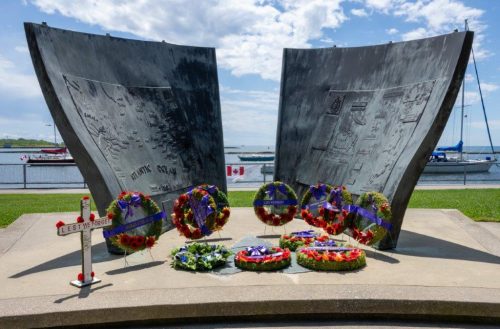
The Monument, built in honour of those who died in the Second World War, is dedicated as a tribute to all Canadians at home and overseas who served their nation with courage, hope and sacrifice during the Second World War II in 1995, the 50th anniversary of its end.
Most of the trees planted in Coronation Park honour the Canadian regiments and units which who participated in the First World War and earlier wars.
The ceremony was organized by the Royal Canadian Legion and the Queen’s Own Rifles of Canada, a Toronto-based regiment, with the support of the city. The Regiment was one of the initial Canadian assault waves to land on the beach that historic day.
On June 6 ‘Toronto Remembers D-Day’ was proclaimed in the City of Toronto. The Toronto sign was lit red, white and blue to represent Canada, the United Kingdom and the United States, the three countries that each were responsible for a beach in Normandy that day, along with France.
The City of Toronto flag that has flown at the Juno Beach Centre in France was raised on the courtesy flag pole at Toronto City Hall.
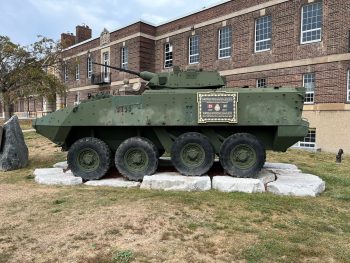
March 12, 2024 marks ten years since the End of Canada’s role in the NATO Mission in Afghanistan.
The mission for Canada began in 2004 and ended on March 12, 2014, when Canadian troops withdrew. Canadian soldiers were first deployed to Afghanistan as part of a Joint Task Force mission in December 2001, following the September 2001 terrorist attacks in the United States. In 2003, the UN Security Council authorized a NATO-led International Security Assistance Force and Canada joined this force with almost 1,000 soldiers stationed in Kabul, Kandahar and elsewhere at any one time and Canadian Forces located in Kandahar province. More information can be found at Veterans Affairs Canada.
Thousands of Canadians were deployed and served in Afghanistan over this period and sadly 158 Canadian soldiers lost their lives.
Joshua Caleb Baker
Nicholas (Nick) Ashley Bulger
Brian James Collier
Demetrios Diplaros
Ainsworth Dyer
Matthew Jonathan Cedric McCully
Mark Robert McLaren
William (Bill) Montague Turner
The impacts of this Mission were not only felt by the Canadians who served, many who experienced, and continue to experience, psychological and physical wounds, but by the Afghan community here and abroad.
The Greater Toronto Area is home to the largest Afghan community in Canada and thousands of Afghan refugees came to Toronto because of this Mission.
Recount the story of Rahim, an interpreter working with the CAF in Afghanistan, who immigrated to Canada and settled in Toronto.
On March 12, 2024, family members, members of the Canadian Armed Forces, residents from the Afghan Community, and member of the public gathered at the LAV III Monument at the Fort York Armouries to commemorate this anniversary. Candles and wreaths were laid to honour the fallen during a ceremony which included remarks, stories from families and those who served, along with a performance from an Afghan girls’ choir.
Following the presence of international coalitions from 2001 to 2014, Afghanistan underwent political and social change. Canada played a significant role in those changes. Following 2014, Canada’s role shifted towards a focus on humanitarian efforts, creating a stable environment, and promoting development.
These efforts supported:
Canada’s presence in Afghanistan fostered resilience and democratic values, which continue to live on despite the change in regime under the Taliban.
Establishing Democracy
The international community supported the promotion of democracy in Afghanistan between 2001 and 2022 through various initiatives and assistance. The people of Afghanistan, especially new generation, were determined for democracy to succeed, recognizing it as a path towards political and social solutions.
A government was establishment based on the will of the people, marked by presidential elections and the ratification of a new constitution in 2004.
Legislative elections granted women the right to vote, while efforts were undertaken to strengthen human rights protections, including laws guaranteeing freedom of the press.
Education Amidst Adversity
The education sector in Afghanistan witnessed significant developments due to international investments. Schools were constructed in the East and Central parts of the country and in rural areas which had not had schools. Most importantly, women and girls had access to educational opportunities.
Enrollment increased to nine million students, girls’ enrollment in post-secondary institutions grew to 85,000, and the female literacy rate doubled over the 20-year period.
Canada’s efforts have helped achieve a 14-year life expectancy gain and directly supported the establishment of more than 9,400 community-based education schools across Afghanistan providing education to approximately 273,000 students, 80% of them girls.
Canada’s efforts to preserve these hard-fought gains continue, as Canadian funding is currently helping to ensure that approximately 25,000 Afghan girls are able to access primary education through community-based education.
Youth in Leadership and Sport
The past two decades saw youth became a significant force in social, political, economic spheres and sport in Afghanistan. Youth, age 18-35, constitute over 65 per cent of the population, with those under 25 making up nearly two-thirds of the population.
Despite patriarchal and discriminatory attitudes, the young represented their country internationally through festivals, contests, and sports events and won several medals in the Summer Olympics, with athletes competing in disciplines like taekwondo and wrestling, Additionally, girls made strides in traditionally male-dominated sports such as boxing, football, skiing, and biking, breaking barriers and inspiring others.
The return of the Taliban in 2021 brought restrictions on social, economic, educational, and political expression in Afghanistan leading to increased insecurity and human right issues.

On July 27, 2023, the City of Toronto commemorated the 70th Anniversary of the Korean War Armistice Agreement. A ceremony was held at the Cenotaph at Old City Hall. City officials, representatives of the Canadian Forces, and the Consul General of the Republic of Korea were in attendance and laid wreaths. Hazel Regan, sister of fallen soldier Private William (Billy) Regan, attended the ceremony and also laid a wreath. Read about Private Regan here.
The Korean War was a conflict between North Korea and South Korea that began in June 1950, when Soviet and China-supported North Korean troops invaded American-supported South Korea. Lasting just over three years, the Korea Armistice Agreement was signed on July 27, 1953, bringing an end to the fighting but not the conflict between the two countries. The Agreement established a two mile-wide (three kilometers) ‘demilitarized zone’ that still exists today. South Korea is now known as the Republic of Korea while North Korea is the Democratic People’s Republic of Korea.
It was only two months into the Korean War that Canada joined the conflict, with many men and women with a connection to Toronto serving in the Canadian Army Special Force. Canada joined the UN Command that included 32 other countries.
A total of 26,971 Canadians served on land, at sea and in the air during the conflict, many remaining as peacekeepers afterward. 516 Canadians were killed during the conflict, including at least 38 of them from Toronto. In 1997, the Korea Veterans Association of Canada erected a monument to remember the fallen.
The following is the list of those with a connection to Toronto who died in the line of duty during the Korean War:
On August 19, 1942, the Allied forces undertook a raid on the French coastal town of Dieppe. Known as Operation Jubilee, almost 5,000 of the 6,000 troops at Dieppe were Canadians. The plan was for the troops to attack Dieppe from five different points along the beach which was surrounded by massive cliffs riddled with German strongholds.
Dieppe was a pivotal lesson for the Allied nations, but it came at a steep price Dieppe had the highest number of Canadian casualties in a single day during World War II. The impact of this day was keenly felt in Toronto as it continues to represent the largest loss of life in a single day, for all wars in Toronto’s history. View the Map of Torontonians Killed in the Dieppe Raid
Of the almost 5,000 Canadians who embarked on the raid, 10 per cent (560) were either born, lived or enlisted in places which are now part of Toronto.
Since 1942, the Dieppe Raid has been remembered on several milestone occasions.
In 1943, the then East York Township council renamed a park as Dieppe Park. In 1953, following a visit to England for the Coronation of Queen Elizabeth II, Mayor Allan Lamport (who was a Squadron Leader with the Royal Canadian Air Force from 1939-1945) visited Dieppe, France. Prisoners of war taken at Dieppe marched on Nathan Phillips Square following a wreath laying at the Old City Hall Cenotaph in 1967 to mark the 25th anniversary. In 1992, 50 years since the raid, Mayor June Rowlands presided over a ceremony, attended by the Governor General, at the Old City Hall Cenotaph. In 2003, a memorial plaque was placed at Dieppe Park to honour those who fought on the beaches.
On August 19, 2022 the City of Toronto held two ceremonies to commemorate the 80th Anniversary of the Dieppe Raid. A wreath laying ceremony was held at Old City Hall cenotaph and an evening commemoration at Dieppe Park brought together family members who shared stories of relatives from Toronto who were Killed in Action, taken Prisoner of War, contributed on the home front and those who returned home as veterans. Wreaths were also laid on the beach and at the Canada memorial in Dieppe, France, by a member of the Toronto Scottish Regiment, one of the units which saw action at Dieppe.
In August 2022, an exhibit about the impact of Dieppe on Toronto was launched in Dieppe Park and travelled to Civic Centres and City Hall, the Fort York National Historical Site, Long-Term Care Homes and the Sunnybrook Veterans Centre.

In 2021, Toronto joined in marking 100 years since the adoption of the poppy as a symbol of Remembrance
“In Flanders fields the poppies grow. Between the crosses, row on row…”
This poem, by Canadian John McCrae, began a movement not just in Canada but also in France. The verses were translated and read in every school in France. On November 11 when red poppies are worn throughout Canada, French children also lay wreaths of bright poppies on the war graves of almost 60,000 Canadians in France.
The poem was written by a Canadian and was elevated to iconic status, so it was only fitting that Canada played a pivotal role in becoming the first Commonwealth country to adopt the poppy. It set an important precedent for other countries in the Commonwealth to follow suit.
Madame Anna Guérin was a key player in a charity, the Inter-Allied Children’s League, representing the women and children of the war-devastated areas of France. The League sold poppies to be worn on Armistice Day, as a memorial to “the boys of Canada and the boys of France who sleep side by side in Flanders fields.”
The idea of using the poppy in commemoration of the war heroes originated in the mind of Madame Guérin, known as the “Poppy Lady.” In the scarlet poppies, she saw the color of the blood of brave soldiers. She had seen this blood so many times in hospitals where she had devoted herself to the care of the wounded and conceived the idea of memorializing the poppy as an emblem of the fallen heroes. She then set out to ensure that all the allied countries used it as a remembrance of those who paid the supreme sacrifice.
Anna Guérin was a guest of the Canadian Great War Veterans’ Association (a forerunner of the Royal Canadian Legion) in Thunder Bay in 1921. The Association accepted the poppy as a symbol that could be sold and worn on November 11. This year marks 100 years since Canada adopted the poppy as the principal symbol of Remembrance.
Madame Guérin travelled across Canada to promote this symbol and to encourage fundraising for veterans and those impacted by the war.
On November 11, 1921, she was at Toronto City Hall to present the wreath for the Veterans Association to the Mayor, to be placed on the Cenotaph. Having brought the idea to Canada, she also brought poppies to Toronto for the observance, the second time the public had gathered formally to mark the armistice.
One hundred years later, Canadians continue to wear poppies and place them on Cenotaphs across Canada to remember all who have fallen in service to the country.
The City of Toronto marked the milestone anniversary of the poppy with various activities:
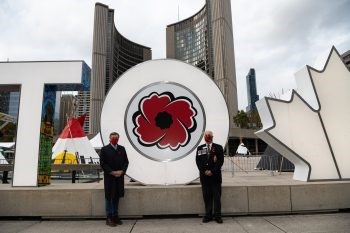
Then-Mayor John Tory and Gerry Morgan, District Commander, Royal Canadian Legion unveiled a poppy insert on November 3, 2021.
As a legacy of the centennial of the Poppy, the City of Toronto installed a poppy in the last “O” of this iconic sign and landmark. The poppy will be used in future years on occasions of Remembrance.

During Remembrance Week, two thousand City of Toronto vehicles proudly displayed the 100th anniversary of the Poppy logo decals.
The City of Toronto’s Year of the Poppy Commemorative Project was funded by the Government of Canada through Veterans Affairs Canada’s Commemorative Partnership Program.

November 11, 2020, marked 100 years since we started to commemorate Remembrance in Toronto on what was Armistice Day until 1931
On November 11, 1920, the City marked its first officially organized ceremony of commemoration. A crowd of 10,000 Torontonians gathered that morning at Old City Hall. A temporary cenotaph was constructed in front of City Hall to symbolize the graves of the fallen who were buried overseas, at the request of the then Mayor, Thomas Langton Church.
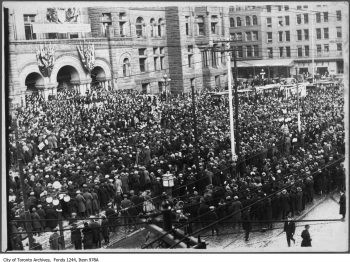
Floral wreaths and arrangements were laid at the base of the temporary cenotaph by families of the fallen soldiers and other organizations. It was the first time that floral wreaths paid tribute to the soldiers’ sacrifice.
Earlier that morning, before the official ceremony began, two grieving Toronto mothers were the first to independently lay wreaths at the temporary cenotaph. Although this wreath-laying was not part of the official programme, this was the only grave they had for their sons.
The Salvation Army band played music until noon while wreaths were laid. The temporary cenotaph was guarded by four dragoons as well as colours of the Royal Canadian Regiment.
Remembrance Day has remained an official day to mark the fallen, for many in Toronto. Here are some photographs of the annual ceremony over the past century.
The City of Toronto commemorated the 75th anniversary of the Second World War in Coronation Park as part of Remembrance Week in 2020. This video shows Canadian flags being planted around the Victory-Peace Monument by the Mayor, the Canadian Armed Forces, the Royal Canadian Legion and Youth to memorialize the 3,452 Torontonians who fell during the War.
Torontonians made a significant contribution to the war, on the battlefields of Europe, in the Pacific, the oceans of the Atlantic, and on the Homefront. Toronto’s Golden Book of Remembrance lists the names of 3,452 service men and women that made the ultimate sacrifice in giving their lives in service to Canada. Thousands more served and survived, many with physical and emotional wounds they carried for the rest of their lives.
Read about some of the heroes mentioned and listen to a few of their stories on the Golden Book of Remembrance page. You can also listen to our Second World War veterans’ stories on our Veterans Memories page.
Victory in Europe (V-E) Day on May 8, 1945 marked the official end of the Second World War in Europe. It was a joyful day celebrated by many in Canada, Europe and other Allied Nations around the world.
On May 8, 2020, the City of Toronto commemorated 75 years since V-E Day by honouring all those who made the ultimate sacrifice as well as our surviving Second World War veterans. In addition, we remembered the triumphant scenes that unfolded across Toronto and around the world on that day, which reminded us of the resilience of the people who had all contributed to the victory.
The 75th anniversary of V-E Day was an especially important recognition due to the aging veteran population, the limited opportunities remaining to thank them for their service, and the COVID-19 pandemic that has affected the older members of our community.
The Second World War was a defining event in Canadian history, transforming a quiet country into a key player in the most important struggle of the 20th century. Among the million Canadians who served in the military, 47,000 Canadians gave their lives, more than 3,400 of these were from Toronto.
Globally, the War claimed the lives of more than 80 million worldwide from virtually every nation. Many of those who fought, on all sides, have since settled in Toronto along with refugees as a result of the war.
The war was a total effort which involved many on the home front who worked in factories, aided militia and reserve regiments, promoted public spirit and morale of the troops and supported their loved ones who were abroad and at sea.
At war’s end, Canada had become a significant military power with the world’s third largest navy, the fourth largest air force and an army of six divisions. Canada had grown significantly through the ordeal of the war and assumed new responsibilities as a leading member of the world community.
Although most of Toronto’s military contributions were involved in the European conflict, the Second World War officially ended on August 15, 1945 when Japan surrendered, finally ending all hostilities.
V-E Day has been commemorated in the past by the City of Toronto on significant anniversaries.
V-E Day: See the virtual: V-E Day photo exhibit.
Homefront: See the virtual Homefront photo exhibit
The Mayor placed a wreath at the Old City Hall Cenotaph at dawn to commemorate all those who paid the ultimate sacrifice during the Second World War.
A large sized Canadian Flag was raised on Nathan Phillips Square at Toronto City Hall in a spirit of celebration to mark the 75th anniversary of V-E Day. The flag was raised as a lone trumpeter played Reveille, a bright, cheerful call to rouse soldiers from their slumber, ready for the day ahead. The Reveille symbolizes an awakening in a better world for the dead, and rouses the living to duty after paying respects to their fallen comrades.
June 6, 2019 marked the 75th anniversary of D-Day, when we remembered the courage of those who fought in the Allied Forces’ invasion of Normandy, France. This anniversary was marked in a solemn ceremony at the Cenotaph at Old City Hall in addition to other initiatives, partnerships and commemorative activities.
In previous years, the City of Toronto D-Day commemorations have featured a Canadian D-Day veteran as a guest speaker. We were honoured to have had the veterans join us for the City’s D-Day ceremonies. View their remarks.
D-Day was part of Operation Overlord, the plan for the liberation of Europe. It was the final push by the Allied Forces to win back control of Europe during the Second World War. The D-Day invasions were the start of the year-long Battle of Normandy. It would end with the German surrender on V-E (Victory in Europe) Day, May 8, 1945. The operation was the largest seaborne invasion in history. Canada’s goal was to secure an eight-kilometre-long stretch of French beach and move towards an inland airfield.
The D simply stands for “day.” The designation was traditionally used for the date of any important military operation or invasion. The day before June 6, 1944, was known as D-1 and the days after were D+1, D+2, D+ and so on. As the date of the invasion could only take place in certain weather conditions, planning was based on a day without a date.
Visit the Toronto Archives D-Day Web Exhibit for a collection of photos captured by Lieutenant Gilbert Milne, a photographer with the Royal Canadian Navy.
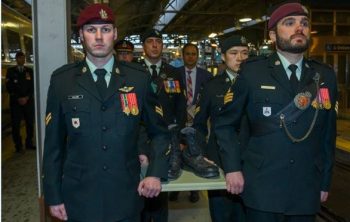
The City of Toronto partnered with Veterans Affairs Canada in hosting the Journey across Canada –Toronto ceremony on May 15, 2019 at Union Station.
The Journey across Canada presents combat boots of veterans as a symbol of the many Canadians who served during the D-Day landings and in the Battle of Normandy. As they stop across the country, ceremonies will commemorate the Canadians who fought and sacrificed to defend peace and freedom during the Second World War.
A pair of combat boots from this initiative were displayed in the Rotunda of Toronto City Hall along with historical photographs on June 6, 2019.
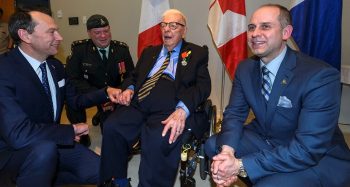
William (“George”) Carpenter was invested as a Knight of the French National Order of the Legion of Honour on May 9, 2019.
William (“George”) Carpenter is a Royal Canadian Artillery veteran of the Second World War, and currently a resident of Kipling Acres, one of 10 long-term care homes operated by the City of Toronto.
On May 9, 2019, George was formally invested as a Knight in the French National Order of the Legion of Honour during a ceremony in Kipling Acres.
The French National Order of the Legion of Honour was established in 1802 by Napoleon Bonaparte. Since 2014, the Government of France has been awarding its highest medal, the Legion of Honour, to veterans who participated in the liberation of France from June 6 to August 30, 1944.
2018 marked 100 years since the end of the First World War, also known as the Great War. To commemorate this anniversary, the City of Toronto hosted several special commemorations.
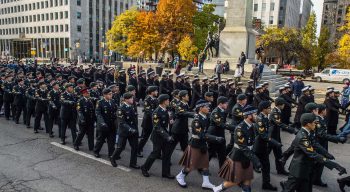
On Sunday, November 11, 500 members of the Canadian Armed Forces paraded north on University Avenue from Union Station to symbolize the return of soldiers from the First World War. They marched from the train station as they would have done in 1918-1919.
250 serving members of the 32 Brigade witnessed the ceremony at the Old City Hall Cenotaph.
An additional 250 members of the Canadian Armed Forces continued to march north to Queen’s Park to participate in the Provincial ceremony.
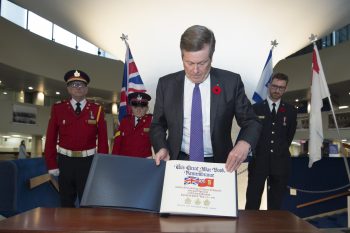
The City of Toronto identified the names of more than 3,200 people who died during the First World War and were members of Toronto-based regiments. To commemorate their sacrifice, a book named the Great War Book of Remembrance was made, which will list the names of these individuals. It was officially dedicated by Then-Mayor John Tory on Wednesday, November 7 at City Hall.
The book has 100 pages to reflect this year’s armistice centennial. 18 of the pages are blank to accommodate more names as they are identified in the years to come.
The title page is calligraphed by Mark Lurz, President of Calligraphic Arts Guild of Toronto. It shows two flags and three badges. The flags are the Royal Union Flag and Red Ensign (1871-1921). The three badges include maple leaves, which would have appeared on soldiers cap badges and buttons and would have helped to identify them as Canadian soldiers.
Then-Mayor John Tory joined the Lieutenant Governor of Ontario, the Hon. Elizabeth Dowdeswell, members of the Canadian Armed Forces and the Commonwealth Consular Corps for a special rededication ceremony on November 10, 2018, in Coronation Park (711 Lake Shore Blvd. W.).
The park is an important commemorative space and is possibly the largest First World War memorial in Toronto. It is being restored to its original design as a permanent memorial to Canada and Toronto’s war effort. The first phase of this redesign was completed in November 2018.

Coronation Park on the waterfront is a living war memorial that was opened to commemorate King George VI’s coronation on May 12, 1937.
The trees in the park commemorate the service and sacrifice of Canada’s military forces, principally those from the Great War (also known as the First World War) and embody the spirit of idealism that emerged following the horrors of the war.
144 trees were planted to commemorate Canada’s military in honour of the King’s coronation. This was the largest tree planting of its kind in Canada at the time. Each tree was ceremonially placed by veterans of the Canadian Expeditionary Force.
On August 1, 1938, veterans returned to simultaneously unveil plaques, with one tree to commemorate each unit that fought.
During the 1939 royal visit of the King and Queen, war veterans and the Men of the Trees and Toronto students planted 123 sugar maples along Remembrance Drive as the royal vehicle passed by.
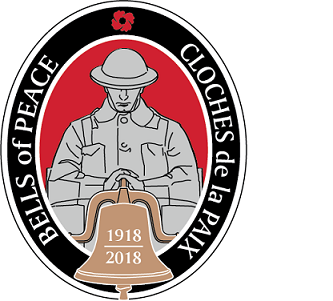
On Sunday, November 11 at sunset (4:56 p.m.) bells across Toronto rang 100 times to commemorate 100 years since the end of the First World War. This initiative, called Bells of Peace, was led by the Royal Canadian Legion in partnership with the Government of Canada.
The ringing of bells symbolized the church bells that rang across Europe in 1918 for the end of the Great War. The City of Toronto rang the bell at Old City Hall.